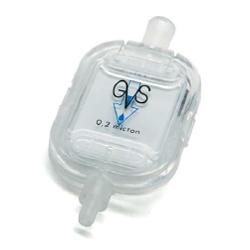Спирометрия
Фильтры, тестирующие функцию легких GVS
Функциональные тесты легких используются для измерения дыхания и того, насколько хорошо функционируют легкие. Основные тесты: Спирометрия, Диффузионный тест и Бодиплетизмография.
Спирометрия
Спирометрия — наиболее распространенный тест функции легких, измеряющий функцию легких, в частности количество (объем) и/или скорость потока вдыхаемого и выдыхаемого воздуха. Спирометрия — важный инструмент, используемый для оценки таких состояний, как астма, фиброз легких, кистозный фиброз и ХОБЛ (Хроническая обструктивная болезнь легких). Спирометрия выполняется с использованием инструмента под названием спирометр. Во время спирометрии пациент обхватывает губами мундштук трубки, соединенной со спирометром, глубоко вдыхает, а затем вдыхает как можно сильнее.
Диффузионный тест легких
Он измеряет, насколько хорошо кислород проходит через воздушные мешочки легкого (альвеолы) в кровоток. Этот тест измеряет рассеивающую способность легких на оксиде углерода. Во время теста пациент сидит, плотно обхватив губами мундштук трубки, при этом на нос одевается специальный зажим, чтобы предотвратить носовое дыхание во время теста. Затем пациент вдыхает небольшое количество газа оксида углерода, задерживает дыхание на 10 секунд, а затем выдыхает как можно быстрее. Затем выдыхаемый газ анализируют, чтобы определить, сколько окиси углерода было поглощено во время дыхания.
Пикфлоуметрия
Пикфлоуметрия (тест на максимальная скорость выдоха или МСВ) — это тест функции легких, измеряющий, насколько быстро человек может выдохнуть. Пикфлоуметрия выполняется с использованием пикфлоуметра. Во время теста пациент глубоко вдыхает, а затем как можно быстрее выдыхает в пикфлоуметр, производящий измерение максимальной скорости выдоха.
Измерения разных легочных тестов включают:
ЖЕЛ — Жизненная емкость легких - Объем воздуха, выдыхаемый пациентом после максимально глубокого вдоха
ФЖЕЛ — Форсированная жизненная емкость легких - Объем воздуха,с усилием выдыхаемый пациентом после максимально глубокого вдоха
ОО — Остаточный объем - Объем воздуха, остающегося в легких после выхода
ПОЛ — Полный объем легких - Максимальный объем воздуха, который пациент способен удержать в легких
ФОО1 — Форсированный остаточный объем за одну секунду - Объем воздуха,с усилием выдыхаемый пациентом после максимально глубокого вдоха за одну секунду
ФОО1/ФЖЕЛ-ФОО1 — в процентах (ФОО1 %) - Отношение ФОО1 к ФЖЕЛ говорит о том, какой процент от общего количества воздуха выдыхается из легких в течение первой секунды выдоха, осуществляемого с усилием
МОСВ — Максимальная объемная скорость выдоха - Позволяет сделать вывод, является ли эффективным лечение таких заболеваний дыхательных путей, как ХОБЛ
СФВ — Скорость форсированного выхода - Измеряет объем выдыхаемого воздуха, чтобы определить наличие большой обструкции дыхательных путей
МПВ — Максимальная произвольная вентиляция - Пациент вдыхает и выдыхает, как можно быстрее и глубже в течение 12 секунд. Результаты отражают состояние дыхательных мышц, жесткость дыхания и наличие сопротивления в дыхательных путях. Тест выполняется перед операцией и определяет, насколько сильны легкие пациента. Плохие результаты говорят о том, что после операции могут возникнуть респираторные осложнения
Бодиплетизмография
Бодиплетизмография — это тест функции легких, который определяет, сколько воздуха находится в легких пациента после глубокого вдоха. Он также измеряет количество воздуха, оставшегося в легких после того, как пациент полностью выдыхает.
Преимущества использования воздушных фильтров во время тестов функции легких
При проведении тестов функции легких между пациентом и тестирующим оборудованием необходимо помещать воздушный фильтр. Основные причины:
- Для защиты оборудования, так как в выдыхаемом пациентом газе могут присутствовать бактерии и вирусы, которые могут потенциально ухудшить качество оборудования.
- Чтобы свести к минимуму риск перекрестного заражения: наибольший риск существует для следующего пациента, который будет проходить тот же тест и может вдохнуть вирусы и бактерии, попавшие в оборудование. Потенциальную опасность хорошо иллюстрирует тот факт, что для инфицирования, таким заболеванием, как туберкулез, достаточно менее 10 бактерий.Пациенты с хроническими респираторными заболеваниями будут подвергаться повышенному риску респираторного заражения. Рекомендуется проводить калибровку оборудования каждый раз после установки фильтра, поскольку фильтр приводит к возникновению дополнительного сопротивления, которое может повлиять на результаты тестов.
Выбор воздушного фильтра
При выборе воздушных фильтров для использования в легочном оборудовании необходимо учитывать три фактора:
- Скорость потока воздуха.
- Уровень сопротивления.
- Эффективность фильтра при задержке частиц.
Фильтры GVS для спирометрии
GVS производит фильтры для тестирования функции легких (Spiroguard) с доказанной эффективностью фильтрации 99,9999 % до 0,027 мкм. Фильтр Spiroguard позволяет проводить испытания без риска перекрестного заражения пациентов, медицинского персонала и оборудования. Фильтры Spiroguard компактны, имеют высокое качество исполнения и гигиенично упаковываются в чистом производственном помещении, чтобы обеспечить максимальную защиту от заражения.
Фильтрующий материал GVS
Фильтрующий материал фильтра GVS Spiroguard электростатически заряжен. В процессе производства на фильтрующих волокнах создаются положительный и отрицательный заряды, это повышает способность фильтра притягивать твердые частицы. В отличие от других фильтров, применяемых при спирометрии, электростатический фильтрующий материал GVS покрыт сетчатым защитным слоем. Он предотвращает рыхление волокон и блокировку спирометра, а следовательно, повышает эффективность защиты от заражения. Фильтрующий материал обладает гидрофобными свойствами, что сводит к минимуму заражение воздушно-капельным путем, а также обеспечивает низкий уровень сопротивления и малое мертвое пространство для повышения достоверности и стабильности результатов дыхательных тестов и сведения к минимуму вероятнсти повторного вдоха.




